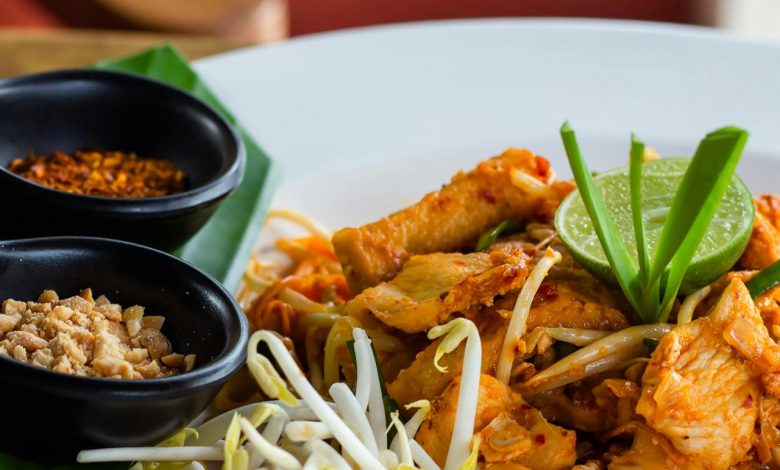
Pad Thai is one of the most beloved and well-known dishes in Thai cuisine. Made with rice noodles, tofu, shrimp (or chicken), egg, peanuts, and a special sauce, this dish offers a perfect balance of sweet, sour, salty, and spicy flavors. Not only in Thailand but around the world, Pad Thai has become a staple on restaurant menus and offers a delightful culinary experience that can easily be prepared at home.
The History of Pad Thai: The origins of Pad Thai date back to the 1930s. Thai Prime Minister Plaek Phibunsongkhram encouraged the development of a rice noodle-based dish to increase rice consumption and create a national identity. The resulting Pad Thai quickly became Thailand’s national dish and has since established a solid place for itself in world cuisines.
The Secrets of Pad Thai: What makes Pad Thai special is the harmony of its ingredients and the flavor of its sauce. Rice noodles form the base of the dish, while tofu and shrimp (or chicken) provide a source of protein. The egg adds richness and consistency, while peanuts provide a crunchy touch. However, the real secret of Pad Thai lies in its special sauce. Made with tamarind juice, fish sauce, palm sugar, and lime juice, the sauce offers a perfect balance of sweet, sour, salty, and spicy flavors.
Homemade Pad Thai Recipe: Ingredients:
• 200g rice noodles (thin or medium thickness)
• 150g shrimp (or chicken, tofu)
• 2 eggs
• 1/2 cup chopped tofu
• 1/2 cup chopped green beans or Chinese broccoli (gai lan)
• 1/4 cup chopped scallions (green onions)
• 1/4 cup chopped peanuts
• Lime wedges (for serving)
• Fresh cilantro (for serving)
For the Sauce:
• 3 tablespoons tamarind juice
• 3 tablespoons fish sauce
• 2 tablespoons palm sugar (or brown sugar)
• 1 tablespoon lime juice
• 1/2 teaspoon chili flakes (optional)
Instructions: 1. Prepare the Noodles: Soak the rice noodles in hot water for about 10-15 minutes, or cook according to the instructions on the package. Once the noodles are softened, drain and set aside.
2. Prepare the Sauce: In a bowl, mix together the tamarind juice, fish sauce, palm sugar, lime juice, and chili flakes (if using). Continue stirring until the sugar dissolves.
3. Sauté the Ingredients: Heat a wok or large skillet. Add some oil and sauté the shrimp (or chicken, tofu). Set the cooked ingredients aside.
4. Cook the Eggs: In the same pan, scramble the eggs and cook partially.
5. Add the Noodles: Add the noodles to the pan and pour the sauce over them. Mix the sauce thoroughly, ensuring it coats all the noodles.
6. Add Other Ingredients: Add the sautéed shrimp (or chicken, tofu), green beans (or Chinese broccoli), chopped scallions to the pan and stir.
7. Serve: Serve the Pad Thai hot. Sprinkle chopped peanuts on top, add fresh cilantro, and serve with lime wedges.
Tips and Tricks for Pad Thai: • Tamarind Juice: Tamarind juice is a must-have for Pad Thai, giving it a sour and fruity taste. You can find tamarind juice at Asian markets or specialty food stores.
• Fish Sauce: Fish sauce adds a unique aroma to Pad Thai. However, those who don’t want to use fish sauce can use soy sauce instead.
• Wok: Traditionally, Pad Thai is prepared in a wok, which adds a special flavor to the dish. If you don’t have a wok, you can use a large skillet.
• Order of Ingredients: Adding the ingredients in the correct order enhances the flavor of Pad Thai. Sauté the protein first, then cook the eggs, add the noodles, and pour the sauce. Finally, add the vegetables and scallions.
Pad Thai Variations: Pad Thai is a dish that can be adapted to different tastes. You can use chicken, tofu, or vegetables instead of shrimp. Those who like it spicy can increase the amount of chili flakes or add fresh chili peppers. Those who like it sweet can increase the amount of palm sugar or add honey.
Pad Thai has established a solid place for itself in world cuisines as the flavor ambassador of the Far East. This easy-to-make culinary delight offers a perfect balance of sweet, sour, salty, and spicy flavors. By trying the recipe, you can adapt it to your own taste and offer your loved ones an unforgettable culinary experience. Enjoy!


